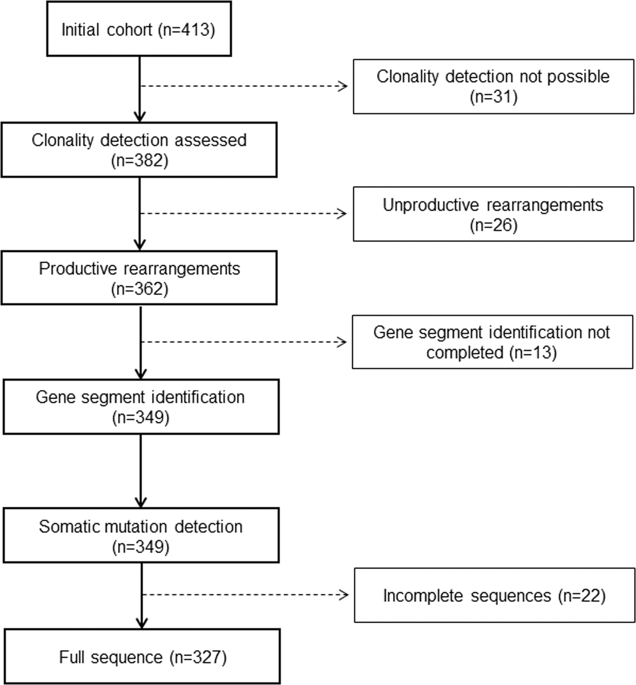当前位置:
X-MOL 学术
›
Blood Cancer J.
›
论文详情
Our official English website, www.x-mol.net, welcomes your
feedback! (Note: you will need to create a separate account there.)
Molecular profiling of immunoglobulin heavy-chain gene rearrangements unveils new potential prognostic markers for multiple myeloma patients.
Blood Cancer Journal ( IF 12.9 ) Pub Date : 2020-02-06 , DOI: 10.1038/s41408-020-0283-8 Alejandro Medina 1 , Cristina Jiménez 1 , M Eugenia Sarasquete 1 , Marcos González 1 , M Carmen Chillón 1 , Ana Balanzategui 1 , Isabel Prieto-Conde 1 , María García-Álvarez 1 , Noemí Puig 1 , Verónica González-Calle 1 , Miguel Alcoceba 1 , Isabel Cuenca 2 , Santiago Barrio 2 , Fernando Escalante 3 , Norma C Gutiérrez 1 , Mercedes Gironella 4 , Miguel T Hernández 5 , Anna Sureda 6 , Albert Oriol 7 , Joan Bladé 8 , Juan-José Lahuerta 2 , Jesús F San Miguel 9 , María-Victoria Mateos 1 , Joaquín Martínez-López 2 , María-José Calasanz 9 , Ramón García-Sanz 1
Blood Cancer Journal ( IF 12.9 ) Pub Date : 2020-02-06 , DOI: 10.1038/s41408-020-0283-8 Alejandro Medina 1 , Cristina Jiménez 1 , M Eugenia Sarasquete 1 , Marcos González 1 , M Carmen Chillón 1 , Ana Balanzategui 1 , Isabel Prieto-Conde 1 , María García-Álvarez 1 , Noemí Puig 1 , Verónica González-Calle 1 , Miguel Alcoceba 1 , Isabel Cuenca 2 , Santiago Barrio 2 , Fernando Escalante 3 , Norma C Gutiérrez 1 , Mercedes Gironella 4 , Miguel T Hernández 5 , Anna Sureda 6 , Albert Oriol 7 , Joan Bladé 8 , Juan-José Lahuerta 2 , Jesús F San Miguel 9 , María-Victoria Mateos 1 , Joaquín Martínez-López 2 , María-José Calasanz 9 , Ramón García-Sanz 1
Affiliation

|
Multiple myeloma is a heterogeneous disease whose pathogenesis has not been completely elucidated. Although B-cell receptors play a crucial role in myeloma pathogenesis, the impact of clonal immunoglobulin heavy-chain features in the outcome has not been extensively explored. Here we present the characterization of complete heavy-chain gene rearrangements in 413 myeloma patients treated in Spanish trials, including 113 patients characterized by next-generation sequencing. Compared to the normal B-cell repertoire, gene selection was biased in myeloma, with significant overrepresentation of IGHV3, IGHD2 and IGHD3, as well as IGHJ4 gene groups. Hypermutation was high in our patients (median: 8.8%). Interestingly, regarding patients who are not candidates for transplantation, a high hypermutation rate (≥7%) and the use of IGHD2 and IGHD3 groups were associated with improved prognostic features and longer survival rates in the univariate analyses. Multivariate analysis revealed prolonged progression-free survival rates for patients using IGHD2/IGHD3 groups (HR: 0.552, 95% CI: 0.361-0.845, p = 0.006), as well as prolonged overall survival rates for patients with hypermutation ≥7% (HR: 0.291, 95% CI: 0.137-0.618, p = 0.001). Our results provide new insights into the molecular characterization of multiple myeloma, highlighting the need to evaluate some of these clonal rearrangement characteristics as new potential prognostic markers.
中文翻译:

免疫球蛋白重链基因重排的分子分析为多发性骨髓瘤患者揭示了新的潜在预后标志物。
多发性骨髓瘤是一种异质性疾病,其发病机理尚未完全阐明。尽管B细胞受体在骨髓瘤的发病机理中起着至关重要的作用,但克隆免疫球蛋白重链特征对结局的影响尚未得到广泛研究。在这里,我们介绍了在西班牙试验中治疗的413名骨髓瘤患者中完整重链基因重排的特征,其中包括以新一代测序为特征的113名患者。与正常的B细胞库相比,骨髓瘤的基因选择存在偏倚,其中IGHV3,IGHD2和IGHD3以及IGHJ4基因组明显过多。我们患者的高突变率很高(中位数:8.8%)。有趣的是,对于不适合移植的患者,单变量分析显示,高突变率(≥7%)以及使用IGHD2和IGHD3组可改善预后,并延长生存率。多变量分析显示使用IGHD2 / IGHD3组的患者无病生存率延长(HR:0.552,95%CI:0.361-0.845,p = 0.006),以及超突变≥7%(HR :0.291,95%CI:0.137-0.618,p = 0.001)。我们的结果为多发性骨髓瘤的分子表征提供了新的见识,强调了需要评估这些克隆重排特征中的一些作为新的潜在预后标记。多变量分析显示使用IGHD2 / IGHD3组的患者无病生存率延长(HR:0.552,95%CI:0.361-0.845,p = 0.006),以及超突变≥7%(HR :0.291,95%CI:0.137-0.618,p = 0.001)。我们的结果为多发性骨髓瘤的分子表征提供了新的见识,强调了需要评估这些克隆重排特征中的一些作为新的潜在预后标记。多变量分析显示使用IGHD2 / IGHD3组的患者无病生存率延长(HR:0.552,95%CI:0.361-0.845,p = 0.006),以及超突变≥7%(HR :0.291,95%CI:0.137-0.618,p = 0.001)。我们的结果为多发性骨髓瘤的分子表征提供了新的见识,强调了需要评估这些克隆重排特征中的一些作为新的潜在预后标记。
更新日期:2020-02-06
中文翻译:

免疫球蛋白重链基因重排的分子分析为多发性骨髓瘤患者揭示了新的潜在预后标志物。
多发性骨髓瘤是一种异质性疾病,其发病机理尚未完全阐明。尽管B细胞受体在骨髓瘤的发病机理中起着至关重要的作用,但克隆免疫球蛋白重链特征对结局的影响尚未得到广泛研究。在这里,我们介绍了在西班牙试验中治疗的413名骨髓瘤患者中完整重链基因重排的特征,其中包括以新一代测序为特征的113名患者。与正常的B细胞库相比,骨髓瘤的基因选择存在偏倚,其中IGHV3,IGHD2和IGHD3以及IGHJ4基因组明显过多。我们患者的高突变率很高(中位数:8.8%)。有趣的是,对于不适合移植的患者,单变量分析显示,高突变率(≥7%)以及使用IGHD2和IGHD3组可改善预后,并延长生存率。多变量分析显示使用IGHD2 / IGHD3组的患者无病生存率延长(HR:0.552,95%CI:0.361-0.845,p = 0.006),以及超突变≥7%(HR :0.291,95%CI:0.137-0.618,p = 0.001)。我们的结果为多发性骨髓瘤的分子表征提供了新的见识,强调了需要评估这些克隆重排特征中的一些作为新的潜在预后标记。多变量分析显示使用IGHD2 / IGHD3组的患者无病生存率延长(HR:0.552,95%CI:0.361-0.845,p = 0.006),以及超突变≥7%(HR :0.291,95%CI:0.137-0.618,p = 0.001)。我们的结果为多发性骨髓瘤的分子表征提供了新的见识,强调了需要评估这些克隆重排特征中的一些作为新的潜在预后标记。多变量分析显示使用IGHD2 / IGHD3组的患者无病生存率延长(HR:0.552,95%CI:0.361-0.845,p = 0.006),以及超突变≥7%(HR :0.291,95%CI:0.137-0.618,p = 0.001)。我们的结果为多发性骨髓瘤的分子表征提供了新的见识,强调了需要评估这些克隆重排特征中的一些作为新的潜在预后标记。











































 京公网安备 11010802027423号
京公网安备 11010802027423号